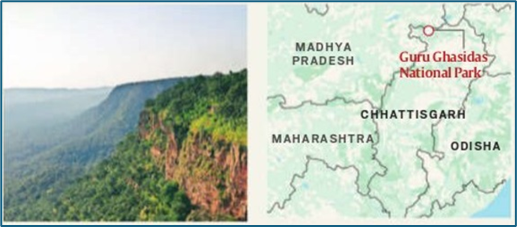Why in news?
Indian government has notified the 56th Tiger Reserve of the country in Chhattisgarh. Guru Ghasidas - Tamor Pingla Tiger Reserve of Chhattisgarh is going to be the 3rd largest in the country.
What’s in today’s article?
- Notification and de-notification of Tiger Reserve
- Guru Ghasidas - Tamor Pingla Tiger Reserve
Tiger Reserves
- About
- A National Park or Wildlife Sanctuary that is considered significant for protecting tigers can be additionally designated as a Tiger Reserve.
- A Tiger Reserve consists of:
- a ‘Core’ or ‘Critical Tiger Habitat’, which is to be managed as an inviolate area, and
- a ‘Buffer’ or Peripheral area, which may be accorded a lesser degree of habitat protection.
- Background
- Project Tiger was launched by the Govt in 1973 to save the endangered species of tiger in the country. As part of this project, the tiger reserves of India were set up.
- These reserves are administrated by the National Tiger Conservation Authority (NTCA).
- How are tiger reserves notified?
- Tiger Reserves are notified by State Governments as per provisions of Section 38V of the Wildlife (Protection) Act, 1972 on advise of the National Tiger Conservation Authority.
- The following steps are involved in the notification:
- Submission of a proposal by the State.
- NTCA granting in-principle approval and requesting detailed proposals.
- NTCA conducting due diligence and recommending the proposal to the State.
- State Government officially notifying the area as a Tiger Reserve.
- Can tiger reserves be altered and de-notified?
- As per Section 38W of the Wildlife (Protection) Act, 1972:
- Changes to tiger reserve boundaries require the recommendation of the Tiger Conservation Authority and approval from the National Board for Wildlife.
- De-notification of a tiger reserve by a State Government is only allowed in public interest with approval from both the Tiger Conservation Authority and the National Board for Wildlife.
Guru Ghasidas - Tamor Pingla Tiger Reserve
- About the reserve
- It is the fourth tiger reserve in Chhattisgarh after Achanakmar, Indravati, and Udanti - Sitanadi.
- With an area of 2,829 sq km, it is the third largest tiger reserve in India.
- Geographical location
- The reserve is spread across four districts in northern Chhattisgarh’s Sarguja region: Manendragarh-Chirmiri-Bharatpur (MCB), Korea, Surajpur, and Balrampur.
- It is located in the northern part of the state, bordering Madhya Pradesh and Jharkhand.
- It falls between two other tiger reserves: Bandhavgarh in Madhya Pradesh and Palamau in Jharkhand.

- Connectivity
- Situated between Bandhavgarh (Madhya Pradesh) and Palamau (Jharkhand) Tiger Reserves, with proximity to Sanjay Dubri Tiger Reserve (Madhya Pradesh), forming the largest contiguous habitat for tigers.
- Wildlife found in the region:
- Includes tigers, elephants, sloth bears, vultures, peacocks, wolves, leopards, otters, chitals, jackals, nilgai, bison, hyenas, langurs, cobras, etc.
- Flora
- The reserve is also rich in flora, with sal, saja, dhavda, and kusum providing the bulk of the tree cover.
- Significance
- Guru Ghasidas National Park was the last known habitat of the Asiatic cheetah in the country.
- Turning Guru Ghasidas into a Tiger Reserve is important because it connects Jharkhand and Madhya Pradesh and provides a corridor for tigers to move between the Bandhavgarh and Palamau Tiger Reserves.
- The state’s tiger population fell from 46 in 2014 to 17 in 2022, the last official tiger status report by the NTCA, released in 2023, revealed.
- Hence, this new Tiger Reserve will help in Tiger conservation in the state.










